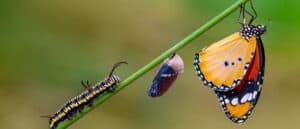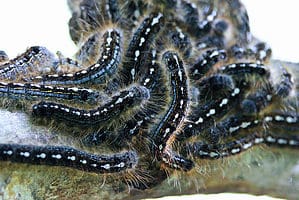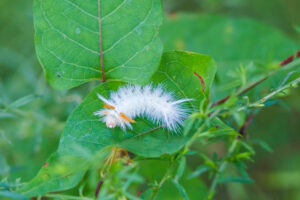Butterflies may seem beautiful and colorful in whatever habitat we see them. Whether we spot them in parks or meadows, they will remain as these magical creatures enhancing the beauty of gardens and nature. But we often forget that these beautiful insects’ larval stage doesn’t look as pleasant as they do now.
First, caterpillars are worm-like insects; hence, not everyone loves them. In addition, all butterflies came from caterpillars, but not all caterpillars are butterflies. Confusing, isn’t it? Caterpillars can be larvae of moths too, and some can sting at their larval stage. As Texas is a state with diverse wildlife and topography, it’s no surprise that it hosts a mindblowing number of caterpillars too.
You can distinguish between caterpillars that will sting you and those that won’t by learning how to recognize caterpillars in Texas. This article will list some of the caterpillars in Texas, their look, and other interesting facts.
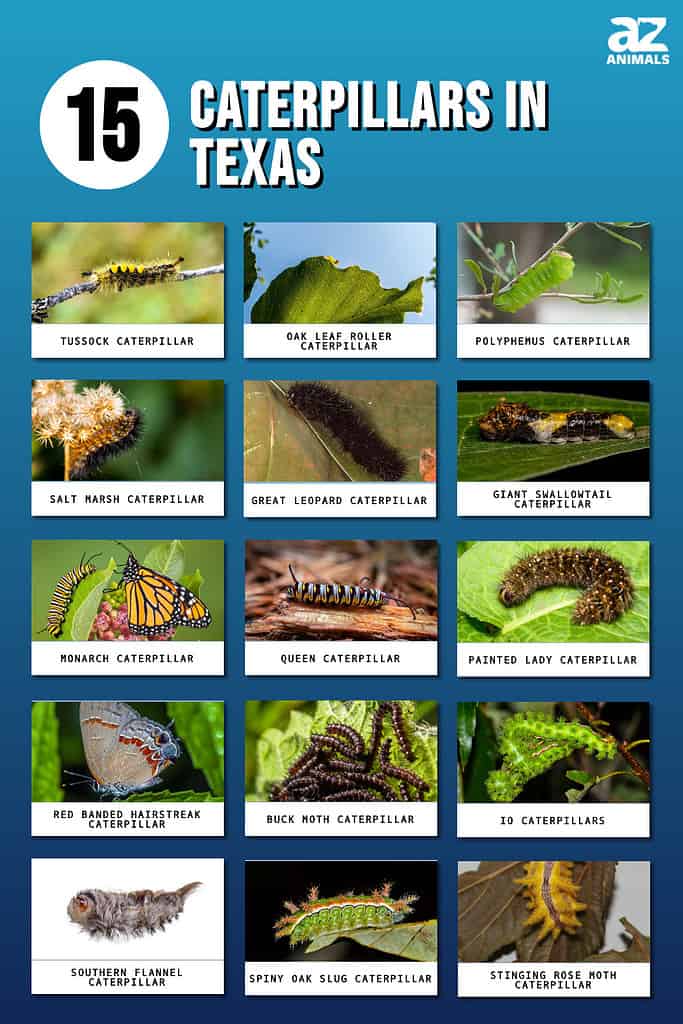
Caterpillars: Moths and Butterflies
Caterpillars appear in a variety of forms, sizes, and hues. Some have hair, some don’t. Some sting rather badly, while others don’t. Some turn into moths, while others change into butterflies. Which is which, then? Generally speaking, moth caterpillars tend to be fuzzier or hairier than butterfly caterpillars, although there are always exceptions, as in nature.
In Texas, there are numerous stinging moth caterpillar species. Caterpillars that sting are frequently hairy or spiky in appearance. These strange-looking caterpillars usually don’t hurt as badly as a bee’s sting. A caterpillar sting can cause itching, blistering, hives, and localized pain. In Texas, though, encounters with stinging caterpillars occasionally necessitate medical attention. Below, we will list the common caterpillars in Texas, categorized as moths, butterflies, and stinging caterpillars.
Moths
1. Tussock Caterpillar
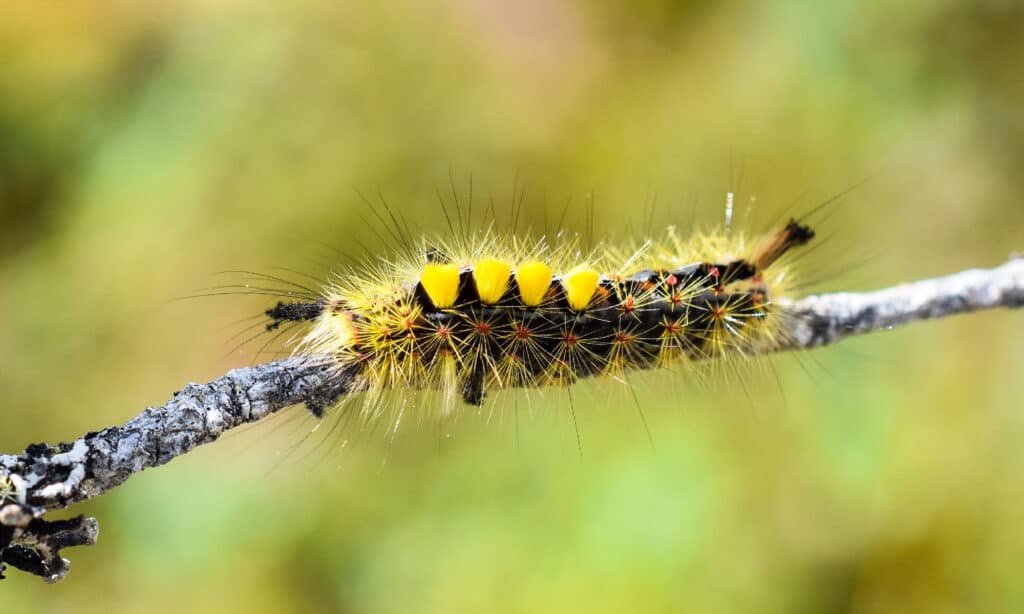
The tussock caterpillar has urticating hairs, which can itch and result in a rash.
©iStock.com/HHelene
A tussock caterpillar is a fuzzy white insect with a black head, black spots down the middle of its back, and two spikes of longer black hairs at the front and back. This larva is hairy, frequently with tufts of hair, and the hairs quickly fall off and are quite irritative to the skin. The tussock caterpillar has urticating hairs, which can itch and result in a rash. The moth uses this incredibly powerful defense throughout its entire existence. Tussock caterpillars will take up residence on almost any coniferous or deciduous tree.
2. Oak Leaf Roller Caterpillar

The oak leaf roller hides in cracks and crevices on trees after they have finished feeding before starting to pupate.
©iStock.com/Karen Richards
We have the tiny green caterpillar hanging from our oak trees every spring. If you’re eating lunch beneath an oak tree, it might even land on your sandwich. Oak leaf rollers are the name for these tiny green and yellow caterpillars. They are between a quarter and an inch in size and eat the delicate new growth of oak trees’ leaves and blooms. The hackberry, pecan, and walnut trees also provide food for the oak leaf roller. They will hang from their web if wind, weather, or predators disturb them. The oak leaf roller hides in cracks and crevices on trees after they have finished feeding before starting to pupate.
3. Polyphemus Caterpillar

The enormous, chubby Polyphemous moth can reach 3 to 4 inches long.
©Chase D’animulls/Shutterstock.com
The huge Polyphemus moth caterpillar is a vivid green silkworm with wispy spines and rows of scarlet red spots. The bright green body segments engorged with red spiky bumps are the telltale signs of the Polyphemus caterpillar.
Bright yellow when immature, the cylindrical-shaped, green crawling insect changes to bright green before pupation. This enormous, chubby larva of a silk moth can reach 3 to 4 inches long. It also has an enormous appetite and may consume 86,000 times its weight in food.
4. Salt Marsh Caterpillar
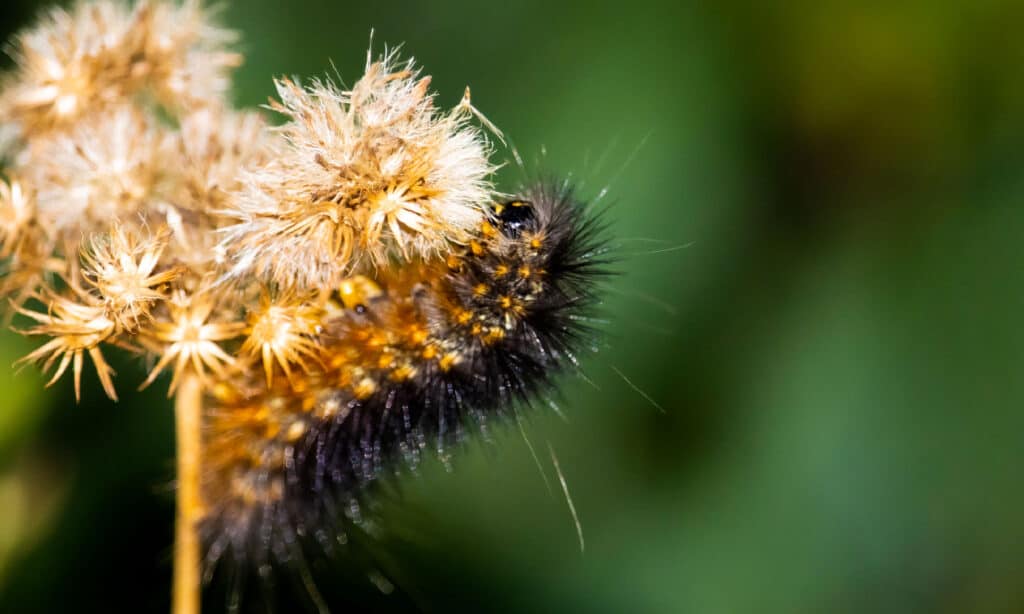
Rows of black or orange lesions with white dots are another distinguishing feature of the salt marsh caterpillar.
©iStock.com/Liudmyla Lesechko
The salt marsh caterpillar is a long, orange-red, or black-haired larva. Rows of black or orange lesions with white dots are another distinguishing feature of the salt marsh caterpillar. The 2-inch long Texas hairy caterpillar consumes the leaves of dandelion, pea, cotton, and cabbage plants. Their color varies; some specimens appear rusty brown and others dark brownish-black.
5. Great Leopard Caterpillar
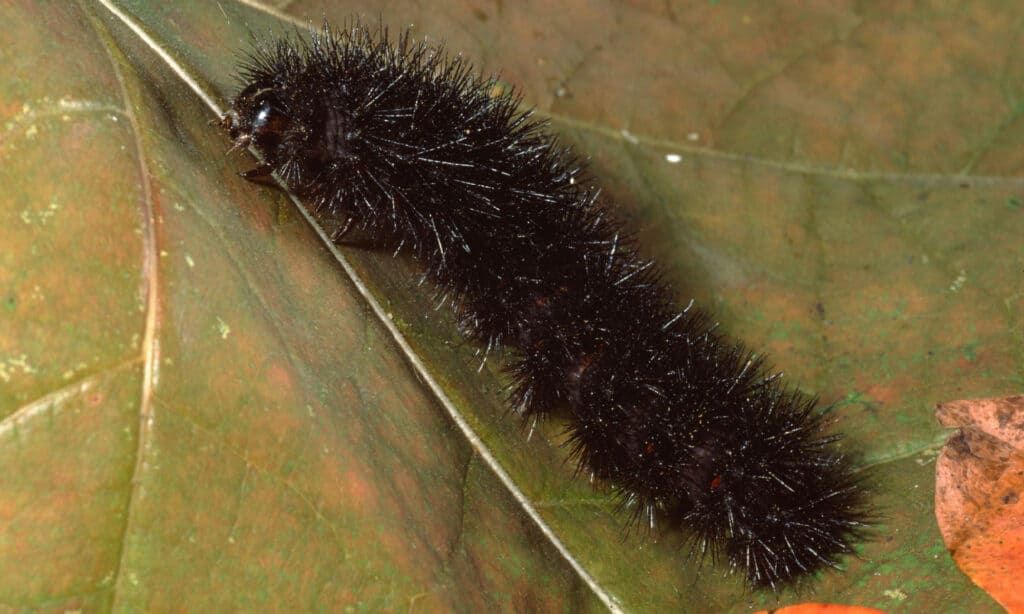
Although they frequently consume weeds, great
leopard
caterpillars are not considered pests.
©iStock.com/Weber
A common caterpillar in Texas is the great leopard moth, which is black and hairy. The great leopard moth caterpillar can be recognized by its densely packed jet-black bristles covering its tube-like body and the bright red bands evident when the caterpillar rolls into a ball. Although they frequently consume weeds, the fluffy black caterpillars are not considered pests. Since their hairs are neither venomous nor irritating, they are usually safe to pick up. Great leopard caterpillars have a maximum length of 2 inches.
Butterflies
1. Giant Swallowtail Caterpillar
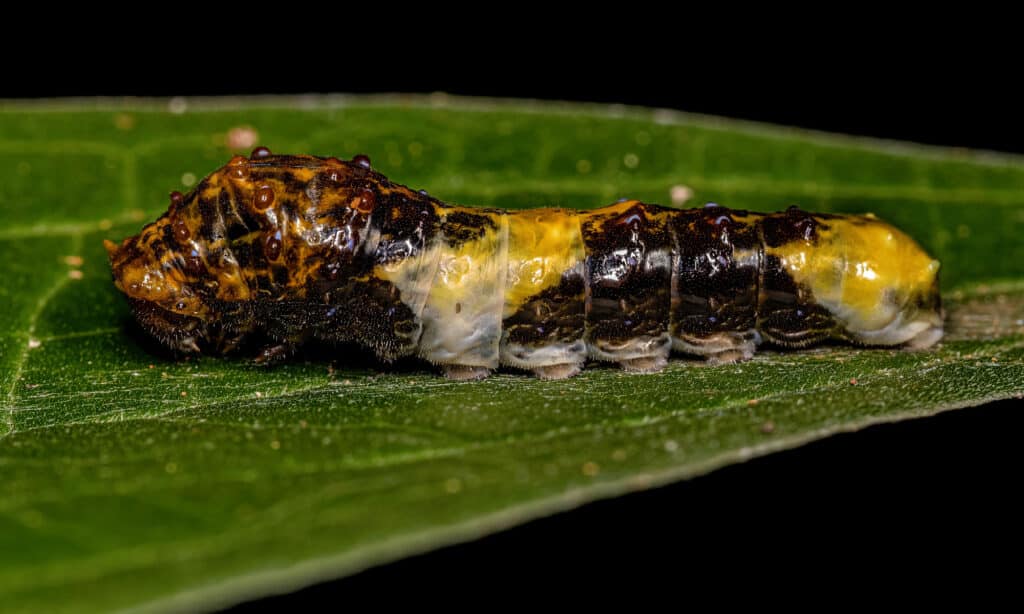
Giant swallowtail caterpillars can be recognized by their white and brown camouflage markings.
©iStock.com/ViniSouza128
A Texas caterpillar that resembles bird droppings is the giant swallowtail. This caterpillar can be recognized by its white and brown camouflage markings. A few more names for the huge swallowtail caterpillar include orange dog, orange puppy, and bird poop caterpillar.
These distinctive brown and white caterpillars measure 2 inches before pupating. They magnificently develop into one of North America’s biggest butterflies, the giant swallowtail, after emerging from the pupa. To fend off predators, the nocturnal larvae feature complex camouflage patterns.
2. Monarch Caterpillar

The yellow, black, and white bands that encircle the fleshy segments of the monarch caterpillar give it a distinctive striped appearance.
©iStock.com/CathyKeifer
The monarch caterpillar is a striped caterpillar that consumes milkweed as it develops, making it unpleasant to birds and other predators. The harmless bug that this southern caterpillar develops into can grow up to 1.7 inches long and 0.3 inches in diameter. The yellow, black, and white bands that encircle the fleshy segments of the monarch caterpillar give it a distinctive striped appearance that makes it simple to identify. At either end of its striped abdomen, the striped Texas caterpillar also bears a pair of fleshy horns.
3. Queen Caterpillar

Queen caterpillars have three sets of tentacles.
©iStock.com/DrWD40
While the queen caterpillar has the same colors as the monarch, its rings and bands are not of the same size. Queens have three sets of tentacles, whereas monarchs only have two sets, which is the most noticeable distinction. Both have characteristic yellow, black, and white striped uniforms, but the queen frequently has a little crimson blend where the caterpillar’s torso and tentacles meet. The stripes’ patterns can change depending on the season, humidity, and diet.
4. Painted Lady Caterpillar
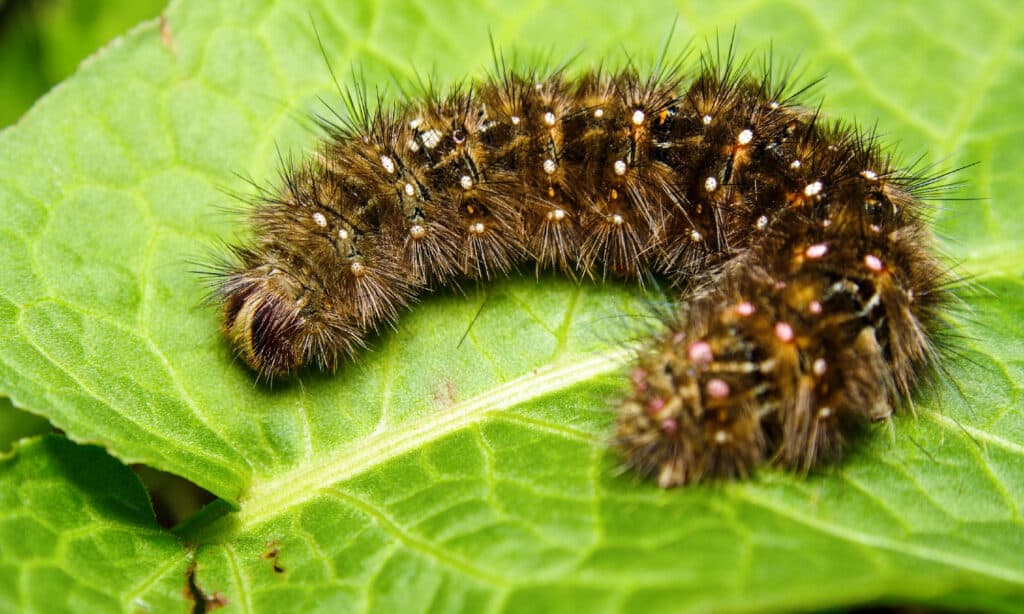
Painted lady caterpillars live alone in one nest and construct a web-like tent.
©iStock.com/Andrew Waugh
The black body of painted lady caterpillars with white spots, bristles covering the body, and branched spines on the segments set them apart from other species. Painted lady caterpillars live alone in one nest and construct a web-like tent. The caterpillars will spend virtually their entire larval life in these protective nests constructed from their silk. When the thistle plants are preparing to flower, keep an eye out for these silken nests.
5. Red Banded Hairstreak Caterpillar
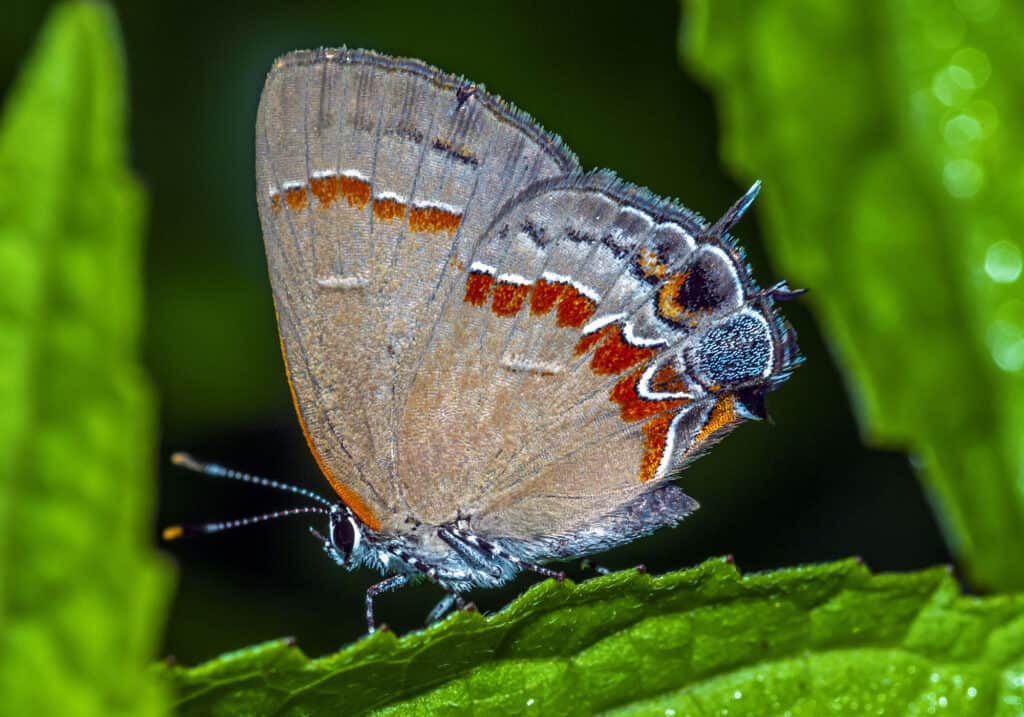
Red-banded hairstreak caterpillars have a stripe along the middle of their back.
©iStock.com/johnandersonphoto
Brown larvae measuring half an inch with a stripe along the middle of the back and covered in short hair are features that define red-banded hairstreak caterpillars. Their body is divided into segments, and each segment has a small, dark dot at each end. They are visible throughout the year in some areas of the United States where they are native, but only between April and October in others.
3. Stinging Caterpillars
“Venomous” caterpillars do not attack, chase after you, or develop into venomous moths. The urticating hairs that are connected to a poison gland are what causes the sting. If you accidentally touch one of these caterpillars or it falls on you, the agony and burning feeling start immediately. Some stings result in red, raised patches and a rash. Below are some examples of stinging caterpillars found in Texas:
1. Buck Moth Caterpillar
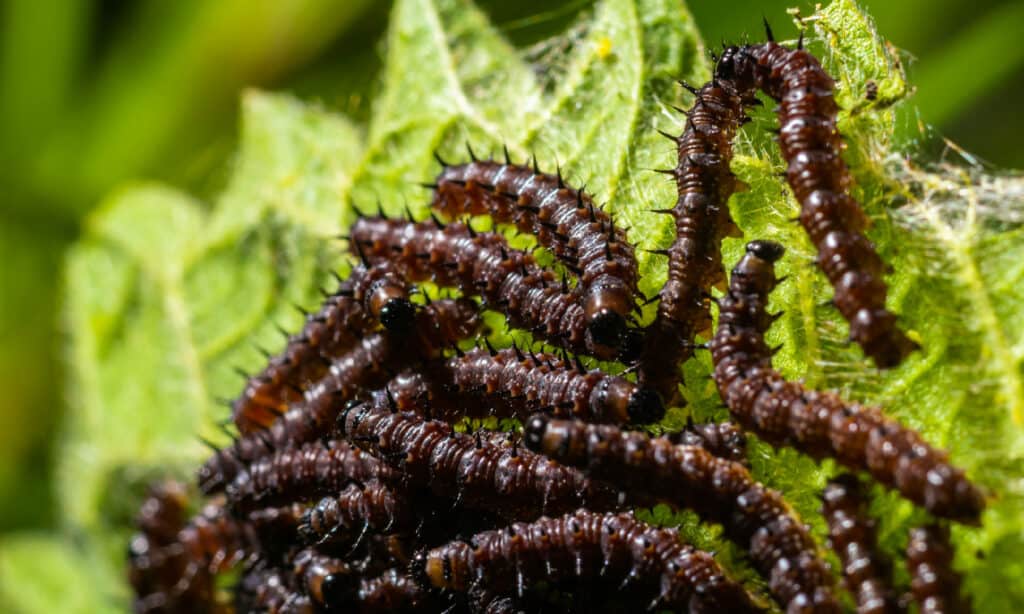
Buck moth caterpillars can be as painful as a bee sting when touched, causing a burning feeling and swelling.
©iStock.com/Oleg Marchak
Buck moth caterpillars have multi-branched dark spines lining each segment of their brown or black bodies, which have tiny white spots and can grow up to 2.5 inches long. The hollow venomous spines or hairs are attached to the poison glands beneath. They can be as painful as a bee sting when touched, causing a burning feeling and swelling. Grass and oak trees are frequent habitats for these caterpillars. They can also be housed on host plants like willow, hazelnut, cherry, and rose.
2. Io Caterpillars
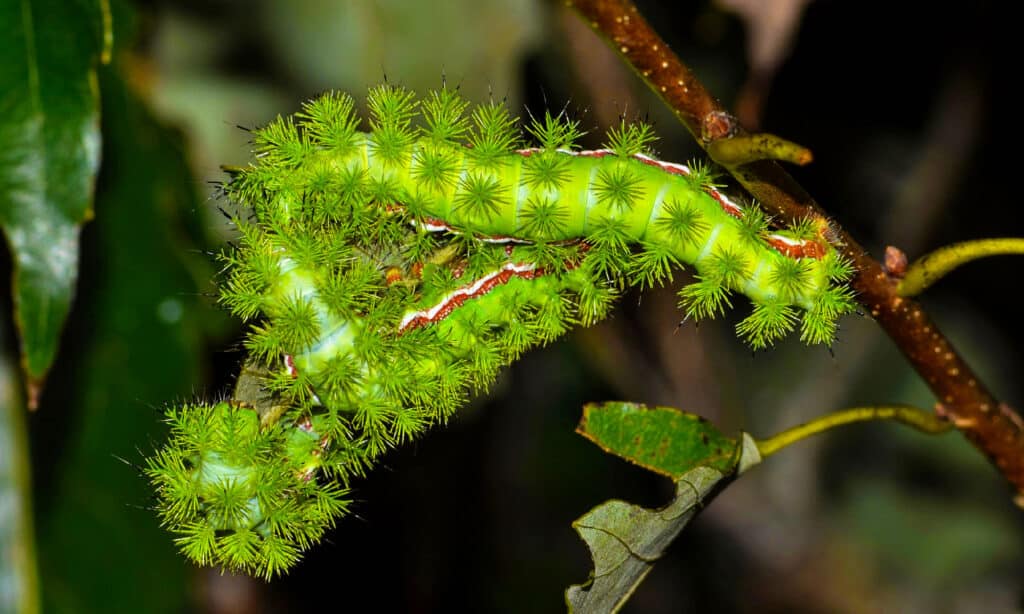
Io caterpillars often emerge in the spring or summer and eat a variety of trees and shrubs.
©iStock.com/Brett_Hondow
Io caterpillars are bristle-haired insects that develop into stinging moths and may be identified by their brilliant green bodies with red and white stripes down the sides. Humans find the bristles on these caterpillars to be quite unpleasant. They often emerge in the spring or summer and eat a variety of trees and shrubs, such as sassafras, willow, oak, maple, elm, holly, aspen, cherry, and pear.
3. Southern Flannel Caterpillar
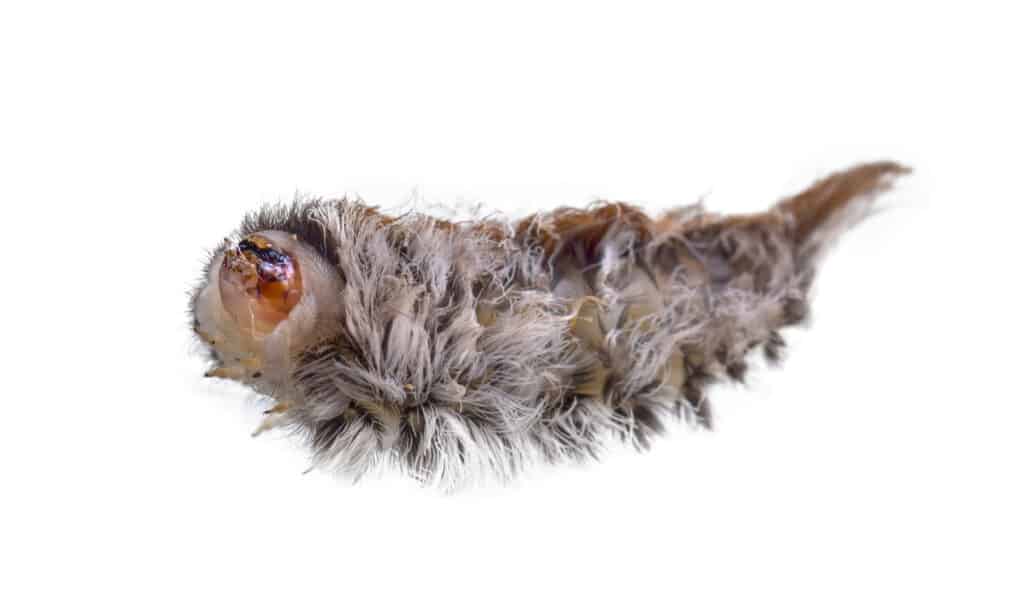
Southern flannel caterpillars are frequently spotted in Texas, Arkansas, New Jersey, and Florida.
©iStock.com/irin717
The one-and-a-half-inch Southern flannel or puss moth caterpillar has a teardrop form with long yellow, gray, or reddish-brown hairs on its fur. They are frequently spotted in Texas, Arkansas, New Jersey, and Florida throughout the spring.
4. Spiny Oak Slug Caterpillar
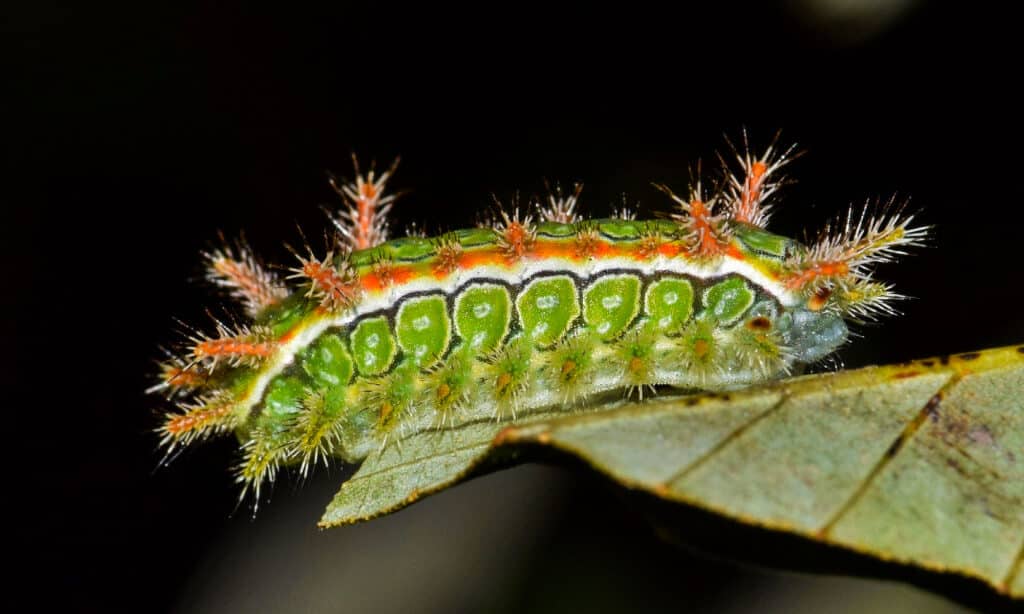
The sides of the spiny oak slug caterpillar’s abdomen contain circular depressions with black or white edges.
©iStock.com/Brett_Hondow
The spiny oak slug caterpillar is identified by its slug-like body that can be green, orange, yellow, or red. The body’s border is surrounded by several pairs of spiky clusters resembling horns on the larvae’s front and back ends. Additionally, the sides of the abdomen contain circular depressions with black or white edges.
5. Stinging Rose Moth Caterpillar
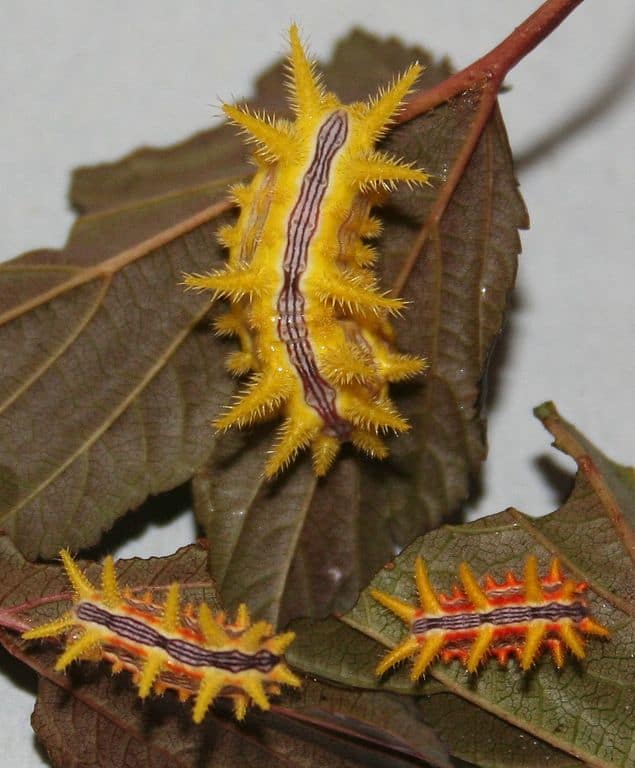
The stinging rose moth caterpillar is one of the oddest caterpillars in Texas.
©Meganmccarty / public domain – License
One of the oddest caterpillars in Texas is the stinging rose moth caterpillar. They have distinguishable spines with fleshy spike covers and a band of thin stripes running down their backs. The inch-long, spiky caterpillars are little and orange and yellow. They frequently eat the leaves of apple, maple, dogwood, oak, and poplar trees. The peculiar Texas caterpillar is a species of stinging larvae, as its common name implies.
Summary of 15 Caterpillars in Texas
| Rank | Caterpillar | Type of Caterpillar |
|---|---|---|
| 1 | Tussock Caterpillar | Moth |
| 2 | Oak Leaf Roller Caterpillar | Moth |
| 3 | Polyphemus Caterpillar | Moth |
| 4 | Salt Marsh Caterpillar | Moth |
| 5 | Great Leopard Caterpillar | Moth |
| 6 | Giant Swallowtail Caterpillar | Butterfly |
| 7 | Monarch Caterpillar | Butterfly |
| 8 | Queen Caterpillar | Butterfly |
| 9 | Painted Lady Caterpillar | Butterfly |
| 10 | Red Banded Hairstreak Caterpillar | Butterfly |
| 11 | Buck Moth Caterpillar | Stinging |
| 12 | Io Caterpillars | Stinging |
| 13 | Southern Flannel Caterpillar | Stinging |
| 14 | Spiny Oak Slug Caterpillar | Stinging |
| 15 | Stinging Rose Moth Caterpillar | Stinging |
The photo featured at the top of this post is © iStock.com/Brett_Hondow
Thank you for reading! Have some feedback for us? Contact the AZ Animals editorial team.



